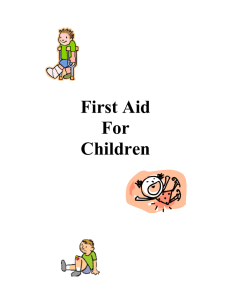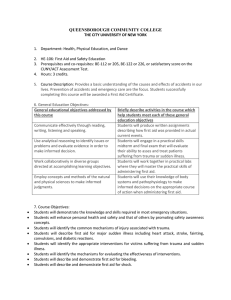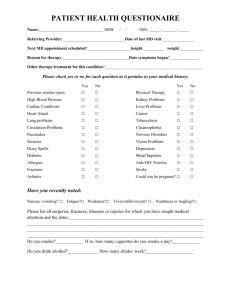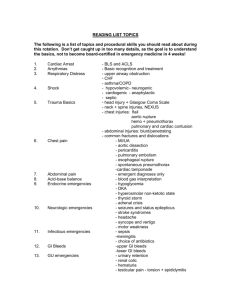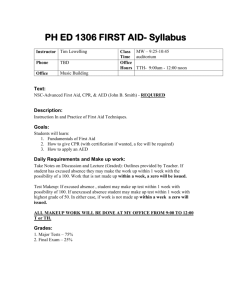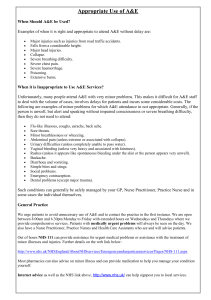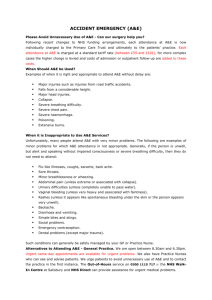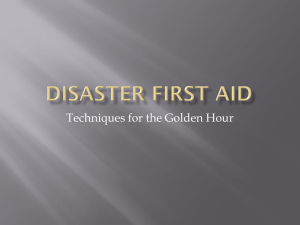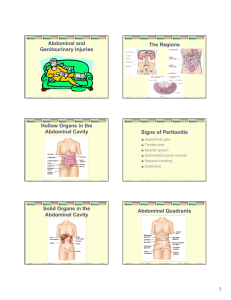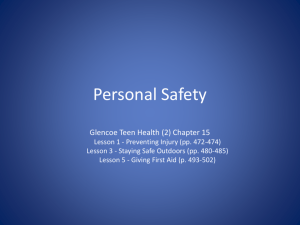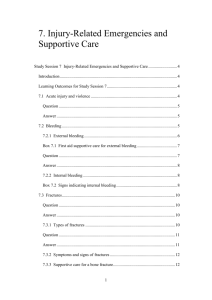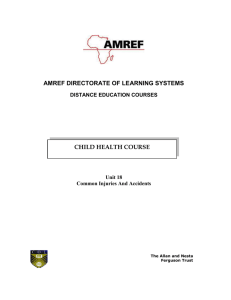First Aid Requirements
advertisement
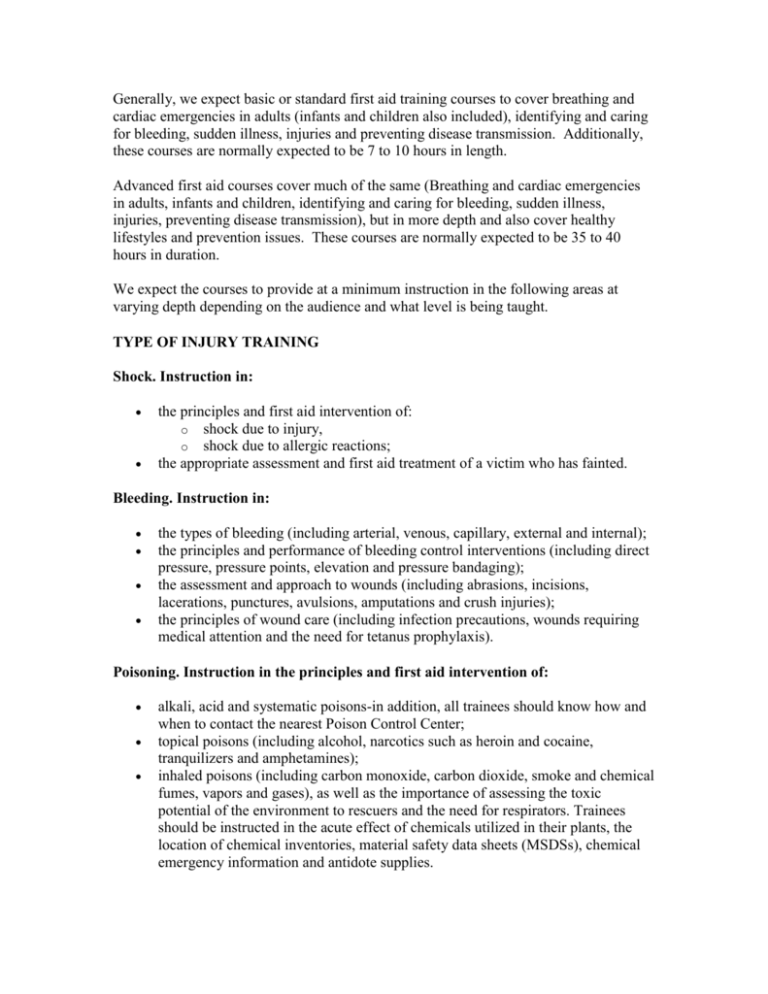
Generally, we expect basic or standard first aid training courses to cover breathing and cardiac emergencies in adults (infants and children also included), identifying and caring for bleeding, sudden illness, injuries and preventing disease transmission. Additionally, these courses are normally expected to be 7 to 10 hours in length. Advanced first aid courses cover much of the same (Breathing and cardiac emergencies in adults, infants and children, identifying and caring for bleeding, sudden illness, injuries, preventing disease transmission), but in more depth and also cover healthy lifestyles and prevention issues. These courses are normally expected to be 35 to 40 hours in duration. We expect the courses to provide at a minimum instruction in the following areas at varying depth depending on the audience and what level is being taught. TYPE OF INJURY TRAINING Shock. Instruction in: the principles and first aid intervention of: o shock due to injury, o shock due to allergic reactions; the appropriate assessment and first aid treatment of a victim who has fainted. Bleeding. Instruction in: the types of bleeding (including arterial, venous, capillary, external and internal); the principles and performance of bleeding control interventions (including direct pressure, pressure points, elevation and pressure bandaging); the assessment and approach to wounds (including abrasions, incisions, lacerations, punctures, avulsions, amputations and crush injuries); the principles of wound care (including infection precautions, wounds requiring medical attention and the need for tetanus prophylaxis). Poisoning. Instruction in the principles and first aid intervention of: alkali, acid and systematic poisons-in addition, all trainees should know how and when to contact the nearest Poison Control Center; topical poisons (including alcohol, narcotics such as heroin and cocaine, tranquilizers and amphetamines); inhaled poisons (including carbon monoxide, carbon dioxide, smoke and chemical fumes, vapors and gases), as well as the importance of assessing the toxic potential of the environment to rescuers and the need for respirators. Trainees should be instructed in the acute effect of chemicals utilized in their plants, the location of chemical inventories, material safety data sheets (MSDSs), chemical emergency information and antidote supplies. Burns. Instruction in: assessing the severity of the burn (including first degree, second degree and third degree burns); differentiating between the types of third degree burns (thermal, electrical and chemical) and their specific interventions-particular attention should be focused upon chemical burns and the use of specific chemicals in the workplace which may cause them. Temperature extremes. Instruction in the principles and first aid intervention of: exposure to cold (including frost bite and hypothermia); exposure to heat (including heat cramps, heat exhaustion and heat stroke). Musculoskeletal injuries. Instruction in the principles and first aid intervention of: open fractures, closed fractures and splinting; dislocations (especially the methods of joint dislocations of the upper extremity) and the importance of differentiating dislocations from fractures; joint sprains; muscle strains, contusions and cramps; head, neck, back and spinal injuries. Bites and stings. Instruction in the principles and first aid intervention of: human and animal bites (especially dog and snake); bites and stings from insects (spiders, ticks, scorpions, hornets and wasps)interventions should include responses to anaphylactic shock, other allergic manifestation, rabies and tetanus prophylaxis. Medical Emergencies. Instruction in the principles and first aid intervention of: heart attacks; strokes; asthma attacks; diabetic emergencies (including diabetic coma, insulin shock, hyperglycemia and hypoglycemia); seizures (including tonic-clonic and absence seizures) and the importance of not putting gags in mouth; emergency pregnancy situations (including the appropriate care of any abdominal injury or vaginal bleeding). Confined spaces Instruction in the danger of entering a confined space to administer first aid without having the appropriate respiratory protection. (If first aid personnel will be required to assist evacuations from confined spaces, additional training will be needed.) SITE OF INJURY TRAINING Instructions in the principles and first aid intervention of injuries to the following sites: Head and neck: o skull fractures, concussions and mental status assessments (with particular attention to temporary loss of consciousness and the need for referral to a physician); o the appropriate approach to the management of the individual who has suffered a potential neck injury or fracture. Eye: o foreign bodies, corneal abrasions and lacerations; o chemical burns and the importance of flushing out the eye; o the importance of not applying antibiotics without physician supervision. Nose. Nose injuries and nose bleeds. Mouth and Teeth. Oral injuries, lip and tongue injuries, and broken and removed teeth. The importance of preventing inhalation of blood and teeth. Chest. Rib fractures, flail chest and penetrating wounds. Abdomen. Blunt injuries, penetrating injuries and protruding organs. Head, finger and foot injuries. o finger-/toenail hematoma, lacerations, splinters, finger avulsion, ring removal and foreign bodies; o the importance of identifying amputation care hospitals in the area. When an amputation occurs, appropriate handling of amputated fingers, hands and feet during the immediate transportation of the victim and body part to the hospital.

